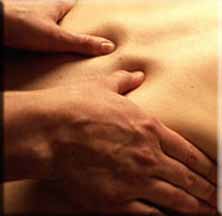

Massage is one of the oldest, simplest forms of therapy and is a system of stroking, pressing and kneading different areas of the body to relieve pain, relax, stimulate, and tone the body.
Massage does much more than create a pleasant sensation on the skin, it also works on the soft tissues(the muscles, tendons, and ligaments) to improve muscle tone.
Although it largely affects those muscles just under the skin, its benefits may also reach the deeper layers of muscle and possibly even the organs themselves. Massage also stimulates blood circulation and assists the lymphatic system (which runs parallel to the circulatory system), improving the elimination of waste throughout the body.
Massage is the practice of applying structured pressure, tension, motion or vibration - manually or with mechanical aids - to the soft tissues of the body, including muscles, connective tissue, tendons, ligaments, joints and lymphatic vessels, to achieve a beneficial response.
A form of therapy, massage can be applied to parts of the body or successively to the whole body, to heal injury, relieve psychological stress, manage pain, and improve circulation. Where massage is used for its physical and psychological benefits, it may be termed "therapeutic massage therapy" or manipulative therapy.
Massage can also be a part of lovemaking for many couple, and often takes place in the context of sex work. As massage is a lightly regulated industry, clients are advised to get references, ask questions and judge for themselves.In commercial settings, massage techniques involve the client being treated lying down on a massage table or in a massage chair, or on a mattress on the floor.
Except for modalities such as Thai Massage or Barefoot Deep Tissue, the massage subject is generally unclothed, and the body may be "draped" with towels or sheets. This also helps keep the client warm. In some jurisdictions it is required that certain areas such as the genitals on both genders and the breast/nipple area on women be draped at all times.
Due to the necessary physical contact between the practitioner and the client, sexual arousal (or signs of it) is possible, but rarely intentional. In Swedish, the most popular style in the USA, the treatment may start with the client face up or down for the first part of the session: the client then rolls over (draped by the towels or sheets) for the second half of the session. Relaxation is necessary for maximum therapeutic benefits to be achieved.
1. Deep relaxation and stress reduction
2. Relief of muscle tension and stiffness
3. Reduced muscle spasm and tension
4. Greater joint flexibility and range of motion
5. Increased ease and efficiency of movement
6. Promotes deeper and easier breathing
7. Better circulation of both blood and lymph fluids
8. Reduced blood pressure
9. Healthier, better nourished skin
10. Improved posture
11. Faster healing time from pulled muscles and strained ligaments
12. Reduced spasm, pain and swelling
13. Reduced formation of scar tissue
14. Strengthened immune system and disease prevention
15. Relaxed state of alertness
16. Reduced mental stress; a calmer mind
17. Greater ability to monitor stress signals and respond appropriately
18. Increased capacity for clearer thinking
19. Satisfying the need for caring and nurturing touch
20. Feeling of well being
21. Greater ease of emotional expression
22. Enhanced self-image
23. Reduced level of anxiety
24. Increased awareness of the mind-body connection
25. A sense of being unified and in harmony
Basics - Interesting Methods of Massage